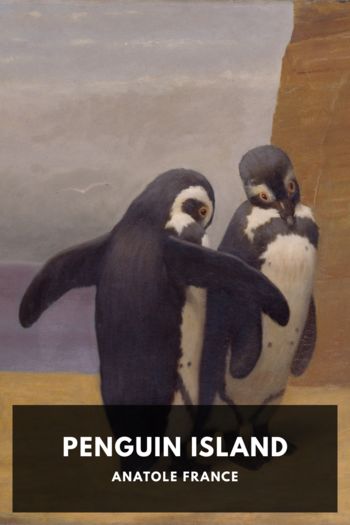Penguin Island Anatole France (speed reading book .txt) 📖

- Author: Anatole France
Book online «Penguin Island Anatole France (speed reading book .txt) 📖». Author Anatole France
At last the Porpoises, having crossed the defiles, laid siege to the monastery. They were warriors from the North, clad in copper armour. They fastened ladders a hundred and fifty fathoms long to the sides of the cliffs and sometimes in the darkness and storm these broke beneath the weight of men and arms, and bunches of the besiegers were hurled into the ravines and precipices. A prolonged wail would be heard going down into the darkness, and the assault would begin again. The Penguins poured streams of burning wax upon their assailants, which made them blaze like torches. Sixty times the enraged Porpoises attempted to scale the monastery and sixty times they were repulsed.
For six months they had closely invested the monastery, when, on the day of the Epiphany, a shepherd of the valley showed them a hidden path by which they climbed the mountain, penetrated into the vaults of the abbey, ran through the cloisters, the kitchens, the church, the chapter halls, the library, the laundry, the cells, the refectories, and the dormitories, and burned the buildings, killing and violating without distinction of age or sex. The Penguins, awakened unexpectedly, ran to arms, but in the darkness and alarm they struck at one another, whilst the Porpoises with blows of their axes disputed the sacred vessels, the censers, the candlesticks, dalmatics, reliquaries, golden crosses, and precious stones.
The air was filled with an acrid odour of burnt flesh. Groans and death cries arose in the midst of the flames, and on the edges of the crumbling roofs monks ran in thousands like ants, and fell into the valley. Yet Johannes Talpa kept on writing his Chronicle. The soldiers of Crucha retreated speedily and filled up all the issues from the monastery with pieces of rock so as to shut up the Porpoises in the burning buildings. And to crush the enemy beneath the ruin they employed the trunks of old oaks as battering rams. The burning timbers fell in with a noise like thunder and the lofty arches of the naves crumbled beneath the shock of these giant trees when moved by six hundred men together. Soon there was left nothing of the rich and extensive abbey but the cell of Johannes Talpa, which, by a marvellous chance, hung from the ruin of a smoking gable. The old chronicler still kept writing.
This admirable intensity of thought may seem excessive in the case of an annalist who applies himself to relate the events of his own time. However abstracted and detached we may be from surrounding things, we nevertheless resent their influence. I have consulted the original manuscript of Johannes Talpa in the National Library, where it is preserved (Monumenta Peng., K. L6., 12390 four). It is a parchment manuscript of 628 leaves. The writing is extremely confused, the letters instead of being in a straight line, stray in all directions and are mingled together in great disorder, or, more correctly speaking, in absolute confusion. They are so badly formed that for the most part it is impossible not merely to say what they are, but even to distinguish them from the splashes of ink with which they are plentifully interspersed. Those inestimable pages bear witness in this way to the troubles amid which they were written. To read them is difficult. On the other hand, the monk of Beargarden’s style shows no trace of emotion. The tone of the Gesta Penguinorum never departs from simplicity. The narration is rapid and of a conciseness that sometimes approaches dryness. The reflections are rare and, as a rule, judicious.
V The Arts The Primitives of Penguin PaintingThe Penguin critics vie with one another in affirming that Penguin art has from its origin been distinguished by a powerful and pleasing originality, and that we may look elsewhere in vain for the qualities of grace and reason that characterise its earliest works. But the Porpoises claim that their artists were undoubtedly the instructors and masters of the Penguins. It is difficult to form an opinion on the matter, because the Penguins, before they began to admire their primitive painters, destroyed all their works.
We cannot be too sorry for this loss. For my own part I feel it cruelly, for I venerate the Penguin antiquities and I adore the primitives. They are delightful. I do not say the are all alike, for that would be untrue, but they have common characters that are found in all schools—I mean formulas from which they never depart—and there is besides something finished in their work, for what they know they know well. Luckily we can form a notion of the Penguin primitives from the Italian, Flemish, and Dutch primitives, and from the French primitives, who are superior to all the rest; as M. Gruyer tells us they are more logical, logic being a peculiarly French quality. Even if this is denied it must at least be admitted that to France belongs the credit of having kept primitives when the other nations knew them no longer. The Exhibition of French Primitives at the Pavilion Marsan in 1904 contained several little panels contemporary with the later Valois kings and with Henry IV.
I have made many journeys to see the pictures of the brothers Van Eyck, of Memling, of Roger van der Weyden, of the painter of the death of Mary, of Ambrogio Lorenzetti, and of the old Umbrian masters.





Comments (0)